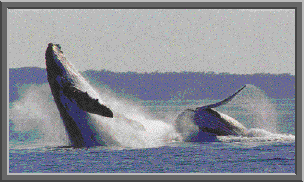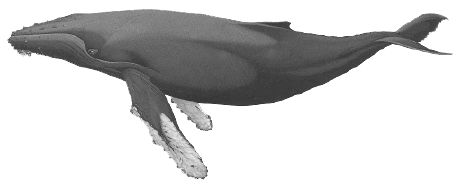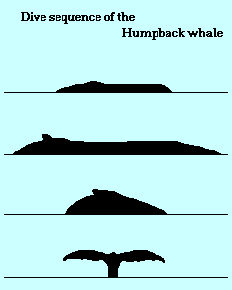|


(Megaptera novaeangliae)
......The
Humpback whale is one of the most energetic of the rorquals. It
is known for its spectacular breaching, flipper-slapping and
lobtailing. It is easily identified at close range by its
knobbly head and long flippers. The black and white colouration
on the underside of the flukes (tail) allows scientists to
distinguish and name individuals all around the world. No two
Humpback whales are exactly alike.
......During
breeding season the Humpback males are known for singing the
longest and most complex songs in the animal kingdom. Humpbacks
are highly inquisitive and will approach quite closely, showing
little fear of boats.
......The
Humpback whale has a more robust body than other rorqual. It's
back and flanks are grey or black with an area of white on the
throat and belly. It has a slender head which constitutes up to
one-third of its total body length. The top of the head is
flattened and covered by a number of fleshy knobs or tubercles.
Unlike other rorquals the midline ridge on the top of the
Humpback's head is indistinct. The lower jaw has a rounded
protuberance near the tip and is covered with similar tubercles
to those on the head. Baleen plates numbering between 270 to 400
are found on each side of the upper jaw. The plates are
relatively short and black or dark grey.

......The
Humpback has exceptionally long flippers with knobs along the
leading edges. While the underside of the flipper is usually
white geographical differences have altered the upper side. On
the flipper of Pacific Humpback the upper side is usually black
whereas in populations of the Atlantic Humpback the upper side
is mostly white with black markings.
......Humpback's
have 14-35 broad throat groves which extend to the naval. The
dorsal fin, placed nearly two thirds along the back, is variable
in shape and size from a small triangular knob to a large
distinctly sickle-shaped fin. The tail flukes are distinctly
notched with trailing edges that are commonly scalloped
(S-shaped) with knobs. The back is typically humped in front of
the dorsal fin and the tail stock is relatively thin.
......The
Humpback has twin blowholes typical of all baleen whales. It's
blow appearing as a single bushy spout extending to 3m (10ft) in
height.
Subfamily: Megapterinae
Other Names: Hump-backed Whale.
......Humpback
whales are wide ranging and can be found virtually worldwide,
but with apparent geographical segregation between at least ten
populations. Although some mixing does occur between these
populations there has probably never been any contact between
the Northern and Southern hemispheres. Humpbacks are strongly
migratory, seasonally migrating from polar feeding grounds to
warm temperate to tropical breeding grounds.
......Estimated
at around 10,000 individuals worldwide the Humpback is an
'Endangered Species'. The healthiest populations occur in the
western north Atlantic Ocean. A few other areas, include the
waters near Beguia, Cape Verde, Greenland, and Tonga.
......Due
to their tendency to aggregate on the tropical breeding grounds
and to come close to the shore on the polar feeding grounds the
Humpback whales were highly vulnerable to whalers. It is likely
that more than 100,000 humpbacks were killed by whalers
throughout the modern whaling era and, although some stocks seem
to be recovering, today's population is still a fraction of its
original size. Humpback whales received protection in 1966 and
again in 1985 when the International Whaling Commission
instituted a moratorium on commercial whaling.
Length: 12-15 metres (40-60 feet)
Life-span 70-80 years.
......Humpback
whales in the Southern Hemisphere are proving to be different
from those north of the equator (the northern species is known
as M. n. angliae). The Humpback Whale is unlike any other
Rorqual. The body is robust and narrows rapidly in front of the
huge tail flukes. The head is broad and rounded, but the median
ridge is indistinct and has been replaced by a string of fleshy
knobs. Two further lines are arranged along the jaws.

......The
fin is small and varies in shape from triangular to shark-like.
It is set two-thirds of the way back and mounted on a fleshy
platform unlike that of any other Baleen whale. The most
characteristic feature of the humpback is its enormous flippers.
They are almost a third of total body length, about 5 metres (16
feet) long and heavily scalloped.
......The
whale's colour is generally blackish with a white area covering
the throat grooves. It has broad flukes with highly scalloped
edges, moderately notched. The underside of the flukes are
marked with a variable pattern of white, making each whale
recognizable at the surface as it throws its tail into the air.
The flippers are mottled black and white with white underneath.

......The
blow is distinctive, seldom more than 3 metres high (10 feet)
and is a single, straight column that spreads at the top, like
the spout of a fountain. Breathing sequence usually involves 2
or 3 minutes at the surface, blowing once every 20-30 seconds,
followed by a deep 'humpbacked' dive for 3-28 minutes. The fin
is seldom seen until the high, rolling dive brings the hump into
view before sounding. In warmer water, the number of breaths
taken between dives is reduced from an average of 6 to 3.
......Humpbacks
often leap clear of the water, usually in an arching backflip,
which brings the pale pleats of the throat into view. These
whales can often be found lying motionless on the surface with
one flipper hoisted like a sail. This raised flipper can slap
the water hard, producing a noise like a gun shot. An even
louder sound can be made by bringing the tail down sharply upon
the water surface. This is called a lobtail. |